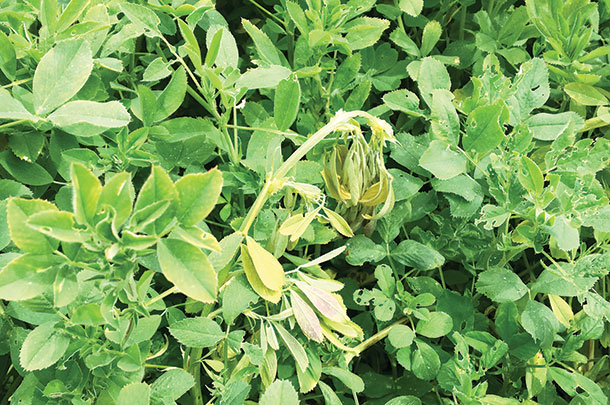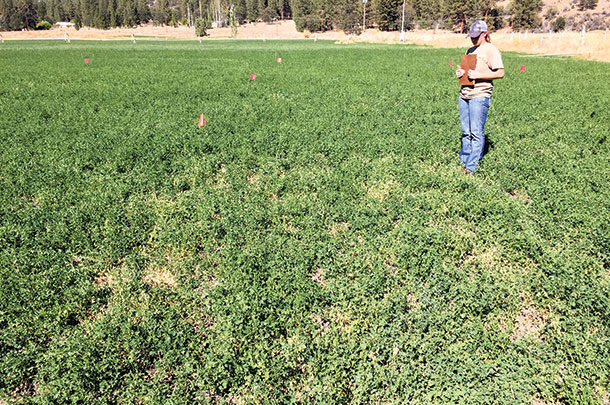The primary advantages are improved weed control, ease of use and avoidance of crop injury. However, during the spring of 2014, we were surprised to see what appeared to be significant crop injury in commercial RR alfalfa fields in Scott Valley, a high-elevation valley located in the intermountain area of northern California.
A portion of a field where irrigation wheel-lines were anchored for the winter was left untreated, and the alfalfa growth was significantly taller in that area compared with the treated portions of the field.
This was a real mystery, as previous research and grower experience after years of RR alfalfa use had not indicated an injury problem. Logical potential causes for poor growth in the Roundup-treated area, such as spray-tank contamination, a bad batch of glyphosate or non-herbicide-related management practices (fertilization, irrigation, pest management, etc.), were systematically ruled out.
A test plot was conducted in the untreated strip using Roundup from different sources and two rates with and without surfactant to see if the injury could be duplicated. No injury symptoms or effect on alfalfa growth was observed in any of the plots.

This left us perplexed as to what could possibly be the cause for the injury. We initially thought the effect may be an unexplainable single-year aberration, but then the same type of injury reoccurred in the spring of 2015. After considerable deliberation, the theory was developed that cold temperatures after an application of glyphosate was a key contributing factor.
This would explain why some fields were affected and others were not, and why we did not observe any symptoms in the test plot that was conducted in 2014. (No frosts occurred after the late date when the application was made.)
In 2015, yield was monitored in three affected commercial RR alfalfa fields in the Scott Valley by harvesting treated and untreated areas with a plot harvester. In the most severely affected field, a first-cutting yield reduction of 0.8 tons per acre was observed. (The alfalfa recovered by second cutting.)
A replicated field experiment was conducted in the spring of 2015 at the Intermountain Research and Extension Center in Tulelake, California. Compared to Scott Valley, alfalfa growth in Tulelake is delayed in the spring, and very late-spring frosts are more commonplace. Alfalfa was treated with 22 and 44 ounces of Roundup PowerMax per acre, and cold temperatures followed within a few days.
A reduction in height was observed as well as a yield reduction of 0.3 and 0.4 tons per acre for the 22- and 44-ounce rates of Roundup, respectively. Injury did not carry over into the second cutting.
An additional field trial was conducted during the summer of 2015 in the same commercial field with significant injury in the spring. The same rates used in the spring trial in Tulelake (22 and 44 ounces of Roundup PowerMax) were applied after first cutting to 6- to 8-inch-tall alfalfa.
The plots were carefully inspected after the application, and no injury symptoms were ever observed on the alfalfa and there was no difference in alfalfa yield the following cutting with any of the treatments – again confirming that cold weather after application was required for injury to occur.
Additional trials were conducted in the fall of 2015. While fall is not a time of year when growers ordinarily treat fields with Roundup, a frost sometime after application is virtually guaranteed, enabling us to further evaluate the theory that cold temperatures after application can result in injury. Alfalfa was treated on weekly intervals at the same rates as the studies mentioned above from mid-September through October.
Within a week after treatment, the same injury symptoms observed in the spring were found in some of the trials. These fall studies suggested that injury was related to the height of the alfalfa (taller alfalfa, around 10 inches, was more susceptible than shorter alfalfa), the age of the stand (older fields were more susceptible than a field planted within a few months), and higher Roundup rates resulted in more injury.
Extensive field trials were conducted this past spring throughout the intermountain area of northern California and included a trial in central Oregon. Field experiments were intended to evaluate the effect of glyphosate on RR alfalfa under different climatic and environmental conditions and to determine the effect of plant height on the occurrence of plant injury.
Overall, injury was less than what had been observed the previous two years, most likely due to more mild nighttime lows in 2016 compared with the previous two years. Alfalfa height at the time of application had a profound effect on crop injury. Again, taller alfalfa had far more injury.
Initial greenhouse studies at University of California – Davis support field observations indicating that injury is possible when freezing temperatures occur after application. More research is needed and is currently underway to determine the actual underlying mechanism for this interaction between a glyphosate application and cold temperatures.
Proposed theories need further investigation before an explanation can be offered, but research to date does show that freezing or near-freezing temperatures after application are a key factor. Applications under warmer conditions have not caused injury.
It appears that growers in areas prone to spring frosts, like the intermountain area of northern California, should pay attention to application timing relative to cold events. There is still a lot we have to learn about this phenomenon. We don’t yet know how soon after an application cold temperatures must occur for there to be crop injury. We also don’t know the precise temperature range at which injury is most pronounced.
However, from what we have observed so far, the most effective mitigation strategy to avoid the possibility of injury is to treat alfalfa when it is relatively short in the spring, rather than waiting until it is 6 inches or taller, unless you are confident near-freezing temperatures are over for the season. In many intermountain areas of the West, spring temperatures are so variable that early treatment is probably the safer option.
It can be extremely difficult to predict the occurrence of late-spring frosts with any accuracy. These research results do not question the value of the RR technology but demonstrate the need to pay attention to weather conditions and alfalfa growth status at the time of application in colder intermountain areas prone to late-spring frosts. ![]()
PHOTO 1: This Roundup Ready alfalfa test plot shows a high rate of glyphosate injury in front of the research assistant, as compared with untreated plots to the sides and back.
PHOTO 2: The tips of glyphosate-affected shoots droop in a “shepherd’s crook.” At first they appear wilted, then often turn chlorotic or yellowish in color and eventually become necrotic. Some of the plants in treated plots appear chlorotic and are significantly shorter than alfalfa in untreated plots. Photos by Steve Orloff.
Steve Orloff is a farm adviser/county director with University of California Extension – Siskiyou County. Email Steve Orloff.











